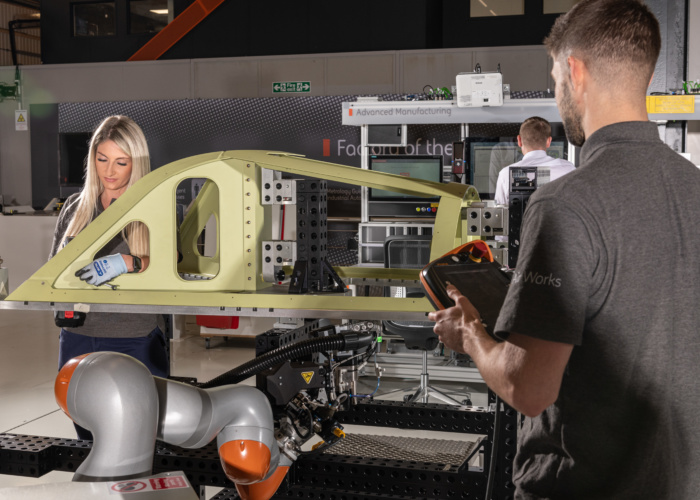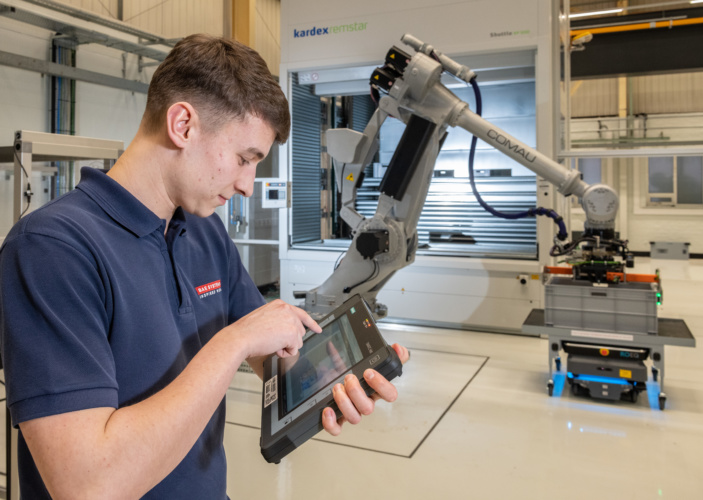There have been many column inches extolling the virtues of 5G. We’ve been told it will revolutionise manufacturing, improve efficiency and productivity, and ultimately lead us to the smart factories of the future. But for most manufacturing firms, the idea of 5G and its lauded benefits still feels a long way off. Not quite science fiction, but not yet a day-to-day reality either.
So how do we get from here to there? How do we move more manufacturers into the digital realm, a promised land where companies can unlock the potential of Industry 4.0 technologies to boost their productivity and competitiveness?
With 5G, we finally have a way to make digital manufacturing a realistic prospect
To realise the possibilities that have been imagined, we need real-world spaces to put theory into practice. The 5G Factory of the Future (5G-FoF) open-access testbed is doing just that - bringing to life the art of the possible for next-gen connectivity in manufacturing. Industry experts and academic leaders are working together to turn the exciting promises of 5G into a working reality for UK businesses.
Led by the University of Sheffield Advanced Manufacturing Research Centre (AMRC), it will be based primarily at the AMRC North West’s soon-to-be-completed £20m facility on the Samlesbury Aerospace Enterprise Zone in Lancashire. Our programme has major global partners in BAE Systems and IBM, along with telecoms provider aql, specialist Lancashire-based firms MTT and Miralis, and leading innovation agency Digital Catapult. Together we’re creating a powerful testbed for trialling new ways of manufacturing, from factory floor to supply chain and everything between.

5G Factory of the Future - the largest 5G testbed investment across all of the manufacturing testbeds in the UK government's £200m 5G Testbed and Trials programme - is a huge investment in the North and a much-needed boost for the Northern Powerhouse. And for manufacturers across the north of England and beyond it means an incredible opportunity to explore the possibilities of 5G - which are now right on their doorstep.
Showcasing the possibilities of 5G
UK manufacturing productivity is already lower than the leading European nations, and the combined impact of Brexit and the pandemic means the need for UK firms to stay competitive has never been more pressing. With 5G, we finally have a way to make digital manufacturing a realistic prospect. By accelerating adoption of Industry 4.0 technologies - using 5G to move manufacturers into the digital fast lane - UK businesses have an opportunity to not just survive, but to thrive.
Until now, digital connectivity simply hasn’t been able to deliver this sort of impact. Wi-Fi, 4G and wired solutions each lack at least one of the fundamental capabilities of mobility, bandwidth, latency or the security needed to be truly useful on an industrial scale.
5G has opened up the door to a whole host of possibilities for manufacturing — closed loop control, tool automation, troubleshooting using augmented reality, remote asset monitoring, digital twins, fully wireless factories and much more.
But in order to truly embrace this potential, we need to see how the technology works in practice.
One of the big goals for 5G Factory of the Future is to improve manufacturers’ understanding of how 5G technology can keep their businesses competitive and sustainable for the future. Our testbed will demonstrate the many ways this technology can be used to improve efficiency, productivity, and sustainability in a live manufacturing setting.
By thoroughly testing these possibilities in this sandbox environment, we can showcase our findings and share our learning to deliver on the promise of smart factories and support businesses to unlock the benefits of industrial digitalisation so they can truly begin to innovate and sharpen their competitive edge.
Putting the technology through its paces
Testing 5G in a real factory environment is vital and we’ve chosen areas within manufacturing where 5G could have the biggest impact.
One of our use cases is real-time process monitoring and control. By using the ultra-low latency of 5G connectivity we can deploy advanced AI technology to improve process precision and predictive maintenance strategies. Initial analysis suggests a 15-25% reduction in the number of defects, amount of waste generated and machine downtime as a result. It's clear to see how improvements like these could translate into dramatic time and cost savings in the real world.
We’re using the power of 5G technology to create digital twins of products and to track the performance, health and locations of assets through the entire product lifecycle. We expect to see significantly improved machine use and factory efficiency through data-driven decision making and real-time asset custody, location and inventory accuracy. We also anticipate improvements in machine scheduling, asset performance and better predictive maintenance.
Other use cases are looking at improving the efficiency and accuracy of manufacturing by adapting processes to compensate for environmental variables such as temperature, humidity and vibration; and using the decreased latency and high bandwidth opened up by 5G for remote inspection and assistance using augmented, virtual and mixed reality across multiple locations. Another area we’re testing is tracking assets throughout the supply chain using 5G sensor and edge computing technologies, and using sensors to monitor the journey of goods in transit to analyse temperature changes and external shocks.
With each use case undertaken in the 5G Factory of the Future testbed, we learn more about how 5G works in practice, and move industry closer to a digital future where connected smart factories start to become a reality.
What’s next for the 5G Factory of the Future?
Our multi-site distributed network goes live this summer, and we’ll begin stress testing these use cases to harness more data about how 5G can support manufacturing businesses. To enable testing in our live environment we’ve had to integrate our computing capabilities with a 5G network — this is a huge milestone for 5G in the UK.

A leading-edge Nokia 5G standalone private network, integrated with IBM’s Hybrid Cloud Data and AI platform, is now live at AMRC North West. This is the first across the manufacturing testbeds within the 5G Testbed and Trials programme.Having the network and compute functions tightly coupled is a distinguishable technical feature of 5G networks and so far it has only been described in textbook configurations. It has now become a reality due to the emerging state-of-the-art 5G network cores, revolutionising the thought process of digital connectivity.
We’re also continuing to develop and improve our own Customer Premise Equipment (CPE)- or simply put, 5G devices. This is the vital hardware that transmits and receives to all devices and keeps the system connected and working. Developing a native 5G device from scratch provides significant benefits in having full control over network performance and allows us to enforce zero-trust security policies.
By developing this solution in-house we can deploy 5G connectivity directly onto machines, robots, PLCs, sensors and devices without any ‘middle-man’ technology such as USB, Ethernet or Wi-Fi, meaning we can maintain end-to-end connection latency at the minimum possible levels. This is crucial for manufacturers because the sooner any deviation from plan is observed, the sooner rectification actions can take place, reducing the downstream impact in terms of cost, rework or waste.
It’s an exciting time to be leading the programme and we’re looking forward to working with businesses in Lancashire, and across the wider North, as our testbed moves into the next phase and sharing our next steps on this incredible journey to a smart and sustainable digital future.
To learn more about the 5G Factory of the Future visit www.5gfof.co.uk




Poll: Should the UK’s railways be renationalised?
Rail passenger numbers declined from 1.27 million in 1946 to 735,000 in 1994 a fall of 42% over 49 years. In 2019 the last pre-Covid year the number...